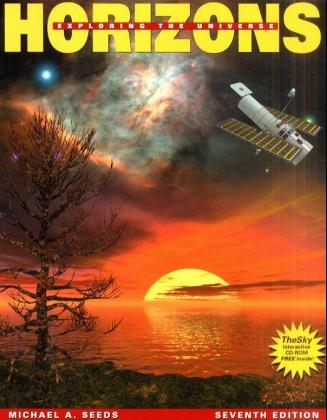
Horizons
Exploring the Universe
Seiten
1999
|
6th edition
Brooks/Cole (Verlag)
978-0-534-37383-2 (ISBN)
Brooks/Cole (Verlag)
978-0-534-37383-2 (ISBN)
- Titel ist leider vergriffen;
keine Neuauflage - Artikel merken
This revised and updated text has two goals: to show students their place in the universe - not just their location, but their role as planet dwellers in an evolving universe - and to show how science works, and how scientists depend on evidence to test hypotheses and build confidence in theories.
This revised and updated 6th edition has two goals: to show students their place in the universe - not just their location, but their role as planet dwellers in an evolving universe - and to show how science works, and how scientists depend on evidence to test hypotheses and build confidence in theories. Essentially, the book can be understood by a principle, organizing theme: the interplay of evidence and hypothesis. Through a discussion of this interplay, it provides not just a series of facts, but a conceptual framework for understanding the logic of astronomical knowledge. A good example of this is how a survey of the solar system in chapter five leads to theories that explain the origin of the solar system, which is followed by further evidence in chapters six to nine that helps students test and generalize theories. At a different level, the paragraphs that discuss Jupiter's rings show how basic observations allow us to propose theories for the origin of the ring particles.
This revised and updated 6th edition has two goals: to show students their place in the universe - not just their location, but their role as planet dwellers in an evolving universe - and to show how science works, and how scientists depend on evidence to test hypotheses and build confidence in theories. Essentially, the book can be understood by a principle, organizing theme: the interplay of evidence and hypothesis. Through a discussion of this interplay, it provides not just a series of facts, but a conceptual framework for understanding the logic of astronomical knowledge. A good example of this is how a survey of the solar system in chapter five leads to theories that explain the origin of the solar system, which is followed by further evidence in chapters six to nine that helps students test and generalize theories. At a different level, the paragraphs that discuss Jupiter's rings show how basic observations allow us to propose theories for the origin of the ring particles.
PART I: THE SKY 1. THE SCALE OF THE COSMOS 2. The Sky 3. Cycles of the Sky 4. The Origin of Modern Astronomy 5. Astronomical Tools PART II: THE STARS 6. Atoms and Starlight 7. The Sun-Our Star 8. The Properties of Stars 9. The Formation and Structures of Stars 10. The Deaths of Stars 11. Neutron Stars and Black Holes PART III: THE UNIVERSE OF GALAXIES 12. The Milky Way Galaxy 13. Galaxies 14. Galaxies with Active Nuclei 15. Cosmology PART IV: THE SOLAR SYSTEM 16. The Origin of the Solar System 17. The Earthlike Planets 18. Worlds of the Outer Solar System 19. Meteorites, Asteroids, And Comets PART V: LIFE 20. Life on Other Worlds APPENDIX A: UNITS AND ASTRONOMICAL DATA / APPENDIX B: OBSERVING THE SKY.
| Erscheint lt. Verlag | 15.8.1999 |
|---|---|
| Zusatzinfo | glossary, index |
| Verlagsort | CA |
| Sprache | englisch |
| Maße | 222 x 286 mm |
| Gewicht | 1111 g |
| Themenwelt | Sachbuch/Ratgeber ► Natur / Technik ► Weltraum / Astronomie |
| ISBN-10 | 0-534-37383-6 / 0534373836 |
| ISBN-13 | 978-0-534-37383-2 / 9780534373832 |
| Zustand | Neuware |
| Haben Sie eine Frage zum Produkt? |
Mehr entdecken
aus dem Bereich
aus dem Bereich
die Suche nach der Urkraft des Universums
Buch | Hardcover (2023)
Klett-Cotta (Verlag)
CHF 34,95
Perspektiven auf die Menschheit
Buch | Hardcover (2024)
Klett-Cotta (Verlag)
CHF 34,95


